Nitrogen and Phosphorus Concentration in Leaf Litter and Soil in Xishuangbanna Tropical Forests: Does Precipitation Limitation Matter?
Abstract
:1. Introduction
2. Materials and Methods
2.1. Study Area
2.2. Litterfall and Soil Sample Collection
2.3. Laboratory Analysis
2.4. Data Analysis
3. Results
3.1. Variation in Soil pH, Litterfall, Leaf Litter and Soil N and P
3.2. Relationship between Main Climatic Factors and Leaf Litter and Soil Nutrients
4. Discussion
4.1. Litterfall Production and Climatic Variables
4.2. Leaf Litter N and P and Precipitation Limitation
4.3. Soil pH, N, P, and Precipitation Limitation
5. Conclusions
Author Contributions
Funding
Acknowledgments
Conflicts of Interest
References
- Agren, G.I.; Wetterstedt, J.A.M.; Billberger, M.F.K. Nutrient limitation on terrestrial plant growth–Modeling the interaction between nitrogen and phosphorus. New Phytol. 2012, 194, 953–960. [Google Scholar] [CrossRef] [PubMed]
- Elser, J.J.; Fagan, W.F.; Denno, R.F.; Dobberfuhl, D.R.; Folarin, A.; Huberty, A.; Interlandi, S.; Kilham, S.S.; McCauley, E.; Schulz, K.L.; et al. Nutritional constraints in terrestrial and freshwater food webs. Nature 2000, 408, 578–580. [Google Scholar] [CrossRef] [PubMed]
- Vitousek, P.M.; Porder, S.; Houlton, B.Z.; Chadwick, O.A. Terrestrial phosphorus limitation: Mechanisms, implications, and nitrogen-phosphorus interactions. Ecol. Appl. 2010, 20, 5–15. [Google Scholar] [CrossRef] [PubMed]
- Bejarano-Castillo, M.; Campo, J.; Roa-Fuentes, L.L. Effects of increased nitrogen availability on C and N cycles in tropical forests: A meta-analysis. PLoS ONE 2015, 10, e0144253. [Google Scholar] [CrossRef] [PubMed]
- Schlesinger, W.H.; Dietze, M.C.; Jackson, R.B.; Phillips, R.P.; Rhoades, C.C.; Rustad, L.E.; Vose, J.M. Forest biogeochemistry in response to drought. Glob. Chang. Biol. 2016, 22, 2318–2328. [Google Scholar] [CrossRef] [PubMed]
- Zak, D.R.; Grigal, D.F. Nitrogen mineralization, nitrification and denitrification in upland and wetland ecosystems. Oecologia 1991, 88, 189–196. [Google Scholar] [CrossRef] [PubMed]
- Vitousek, P.M.; Turner, D.R.; Kitayama, K. Foliar nutrients during long-term soil development in Hawaiian montane rain forest. Ecology 1995, 76, 712–720. [Google Scholar] [CrossRef]
- Huston, M.A. Precipitation, soils, NPP, and biodiversity: Resurrection of Albrecht’s curve. Ecol. Monogr. 2012, 82, 277–296. [Google Scholar] [CrossRef]
- Neelin, J.D.; Münnich, M.; Su, H.; Meyerson, J.E.; Holloway, C.E. Tropical drying trends in global warming models and observations. Proc. Natl. Acad. Sci. USA 2006, 103, 6110–6115. [Google Scholar] [CrossRef]
- IPCC. Climate Change 2013: The Physical Science Basis. Contribution of Working Group I to the Fifth Assessment Report of the Intergovernmental; Stocker, T.F., Qin, D., Plattner, G.-K., Tignor, M., Allen, S.K., Boschung, J., Nauels, A., Xia, Y., Bex, V., Midgley, P.M., Eds.; Cambridge University Press: Cambridge, UK; New York, NY, USA, 2013; 1535p. [Google Scholar]
- Elser, J.J.; Bracken, M.E.S.; Gruner, D.S.; Harpole, W.S.; Hillebrand, N.; Ngai, J.T.; Seabloom, E.W.; Shurin, J.B.; Smith, J.E. Global analysis of nitrogen and phosphorus limitation of primary producers in freshwater, marine and terrestrial ecosystems. Ecol. Lett. 2007, 10, 1135–1142. [Google Scholar] [CrossRef]
- LeBauer, D.S.; Treseder, K.K. Nitrogen limitation of net primary production in terrestrial ecosystems is globally distributed. Ecology 2008, 89, 371–379. [Google Scholar] [CrossRef] [PubMed]
- Powers, J.S.; Becklund, K.K.; Gei, M.G.; Iyengar, S.B.; Meyer, R.; O’Connell, C.S.; Schlling, E.M.; Smith, C.M.; Waring, B.G.; Werden, L.K. Nutrient addition effects on tropical dry forests: A mini-review from microbial to ecosystem scales. Front. Earth Sci. 2015, 3, 34. [Google Scholar] [CrossRef]
- Campo, J. Shift from ecosystem P to N limitation at precipitation gradient in tropical dry forests at Yucatan, Mexico. Environ. Res. Lett. 2016, 11, 095006. [Google Scholar] [CrossRef]
- Yuan, Z.; Chen, H.Y. Global trends in senesced-leaf nitrogen and phosphorus. Glob. Ecol. Biogeogr. 2009, 18, 532–542. [Google Scholar] [CrossRef]
- Reich, P.B.; Oleksyn, J. Global patterns of plant leaf N and P in relation to temperature and latitude. Proc. Natl. Acad. Sci. USA 2004, 101, 11001–11006. [Google Scholar] [CrossRef]
- Zhao, W.; Reich, P.B.; Yu, Q.; Zhao, N.; Yin, C.; Zhao, C.; Li, D.; Hu, J.; Li, T.; Yin, H.; et al. Shrub type dominates the vertical distribution of leaf C:N:P stoichiometry across an extensive altitudinal gradient. Biogeosciences 2018, 15, 2033–2053. [Google Scholar] [CrossRef]
- Fujii, K.; Shibata, M.; Kitajima, K.; Ichie, T.; Kitayama, K.; Turner, B.L. Plant–soil interactions maintain biodiversity and functions of tropical forest ecosystems. Ecol. Res. 2018, 33, 149–160. [Google Scholar] [CrossRef]
- Jiang, F.; Wu, X.; Xiang, W.; Fang, X.; Zeng, Y.; Ouyang, S.; Lei, P.; Deng, X.; Peng, C. Spatial variations in soil organic carbon, nitrogen and phosphorus concentrations related to stand characteristics in subtropical areas. Plant Soil 2017, 413, 289–301. [Google Scholar] [CrossRef]
- Zhou, Y.; Boutton, T.W.; Wu, X.B. Soil phosphorus does not keep pace with soil carbon and nitrogen accumulation following woody encroachment. Glob. Chang. Biol. 2018, 24, 1992–2007. [Google Scholar] [CrossRef] [PubMed]
- Zechmeister-Boltenstern, S.; Keiblinger, K.M.; Mooshammer, M.; Peñuelas, J.; Richter, A.; Sardans, J.; Wanek, W. The application of ecological stoichiometry to plant–microbial–soil organic matter transformations. Ecol. Monogr. 2015, 85, 133–155. [Google Scholar] [CrossRef]
- Vitousek, P.M.; Sanford, R.L., Jr. Nutrient cycling in moist tropical forest. Ann. Rev. Ecol. Syst. 1986, 17, 137–167. [Google Scholar] [CrossRef]
- Jackson, R.B.; Manwaring, J.H.; Caldwell, M.M. Rapid physiological adjustment of roots to localized soil enrichment. Nature 1990, 344, 58–60. [Google Scholar] [CrossRef] [PubMed]
- Chadwick, O.A.; Derry, L.A.; Vitousek, P.M.; Huebert, B.J.; Hedin, L.O. Changing sources of nutrients during four million years of ecosystem development. Nature 1999, 397, 491–497. [Google Scholar] [CrossRef]
- Berhe, A.A.; Torn, M.S. Erosional redistribution of topsoil controls soil nitrogen dynamics. Biogeochemistry 2017, 132, 37–54. [Google Scholar] [CrossRef]
- Vega, J.A.; Fonturbel, T.; Merino, A.; Fernandez, C.; Ferreiro, A.; Jimenez, E. Testing the ability of visual indicators of soil burn severity to reflect changes in soil chemical and microbial properties in pine forests and shrubland. Plant Soil 2013, 369, 73–91. [Google Scholar] [CrossRef]
- Mastrolonardo, G.; Certini, G.; Krebs, R.; Forte, C.; Egli, M. Effects of fire on soil organic matter quality along an altitudinal sequence on Mt. Etna, Sicily. Catena 2013, 110, 133–145. [Google Scholar] [CrossRef]
- Bahr, A.; Ellström, M.; Schnoor, T.K.; Påhlsson, L.; Olsson, P.A. Long-term changes in vegetation and soil chemistry in a calcareous and sandy semi-natural grassland. Flora 2012, 207, 379–387. [Google Scholar] [CrossRef]
- Tang, Z.; Xu, W.; Zhou, G.; Bai, Y.; Li, J.; Tang, X.; Chen, D.; Liu, Q.; Ma, W.; Xiong, G.; et al. Patterns of plant carbon, nitrogen, and phosphorus concentration in relation to productivity in China’s terrestrial ecosystems. Proc. Natl. Acad. Sci. USA 2018, 115, 4033–4038. [Google Scholar] [CrossRef]
- Han, W.; Fang, J.; Guo, D.; Zhang, Y. Leaf nitrogen and phosphorus stoichiometry across 753 terrestrial plant species in China. New Phytol. 2005, 168, 377–385. [Google Scholar] [CrossRef]
- Zhang, C.; Tian, H.; Liu, J.; Wang, S.; Liu, M.; Pan, S.; Shi, X. Pools and distributions of soil phosphorus in China. Glob. Biogeochem. Cycles 2005, 19, GB1020. [Google Scholar] [CrossRef]
- Huang, Z.; Liu, B.; Davis, M.; Sardans, J.; Peñuelas, J.; Billings, S. Long-term nitrogen deposition linked to reduced water use efficiency in forests with low phosphorus availability. New Phytol. 2015, 210, 431–442. [Google Scholar] [CrossRef] [PubMed]
- Mo, J.; Zhang, W.E.; Zhu, W.; Gundersen, P.E.; Fang, Y.; Li, D.; Wang, H.U. Nitrogen addition reduces soil respiration in a mature tropical forest in southern China. Glob. Chang. Biol. 2008, 14, 403–412. [Google Scholar] [CrossRef]
- Janssens, I.A.; Dieleman, W.; Luyssaert, S.; Subke, J.A.; Reichstein, M.; Ceulemans, R.; Ciais, P.; Dolman, A.J.; Grace, J.; Matteucci, G.; et al. Reduction of forest soil respiration in response to nitrogen deposition. Nat. Geosci. 2010, 3, 315–322. [Google Scholar] [CrossRef]
- Paruelo, J.M.; Lauenroth, W.K. Relative abundance of plant functional types in grasslands and shrublands of North America. Ecol. Appl. 1996, 6, 1212–1224. [Google Scholar] [CrossRef]
- Carrera, A.L.; Sain, C.L.; Bertiller, M.B. Patterns of nitrogen conservation in shrubs and grasses in the Patagonian Monte, Argentina. Plant. Soil 2000, 224, 185–193. [Google Scholar] [CrossRef]
- Bertiller, M.B.; Sain, C.L.; Carrera, A.L.; Vargas, D.N. Patterns of nitrogen and phosphorus conservation in dominant perennial grasses and shrubs across an aridity gradient in Patagonia, Argentina. J. Arid Environ. 2005, 62, 209–223. [Google Scholar] [CrossRef]
- Shanmughavel, P.; Sha, L.; Zheng, Z.; Cao, M. Nutrient cycling in a tropical seasonal rain forest of Xishuangbanna, Southwest China. Part 1: Tree species: Nutrient distribution and uptake. Bioresour. Technol. 2001, 80, 163–170. [Google Scholar] [CrossRef]
- Zheng, Z.; Shanmughavel, P.; Sha, L.; Cao, M.; Warren, M. Litter decomposition and nutrient release in a tropical seasonal rain forest of Xishuangbanna, Southwest China. Biotropica 2006, 38, 342–347. [Google Scholar] [CrossRef]
- Liu, W.J.; Zhang, Y.P.; Li, H.M.; Liu, Y.H. Fog drip and its relation to groundwater in the tropical seasonal rain forest of Xishuangbanna, Southwest China: A preliminary study. Water Res. 2005, 39, 787–794. [Google Scholar] [CrossRef] [PubMed]
- Liu, W.; Liu, W.; Li, P.; Duan, W.; Li, H. Dry season water uptake by two dominant canopy tree species in a tropical seasonal rainforest of Xishuangbanna, SW China. Agric. For. Meteorol. 2010, 150, 380–388. [Google Scholar] [CrossRef]
- Cao, M.; Zou, X.; Warren, M.; Zhu, H. Tropical forests of Xishuangbanna, China. Biotropica 2006, 38, 306–309. [Google Scholar] [CrossRef]
- Wang, W.F.; Qui, D.Y.; Wu, J.C.; Ye, H.M. The Soils of Yunnan; Yunnan Science and Technology Press: Kunming, China, 1996. (In Chinese) [Google Scholar]
- Lu, H.Z.; Wu, B.X.; Sha, L.Q.; Wang, J. Seasonal variation of soil respiration and its components in tropical rainforest and rubber plantation in Xishuangbanna, Yunnan. Chin. J. Appl. Ecol. 2009, 20, 2315–2322. [Google Scholar]
- Liu, W.; Luo, Q.; Li, J.; Wang, P.; Lu, H.; Liu, W.; Li, H. The effects of conversion of tropical rainforest to rubber plantation on splash erosion in Xishuangbanna, SW China. Hydrol. Res. 2015, 46, 168–174. [Google Scholar] [CrossRef]
- Cao, M.; Zhang, J.H.; Feng, Z.L.; Deng, J.W.; Deng, X.B. Tree species composition of a seasonal rain forest in Xishuangbanna, south-west China. Trop. Ecol. 1996, 37, 183–192. [Google Scholar]
- Zhang, J.H.; Cao, M. Tropical forest vegetation of Xishuangbanna SW China and its secondary changes, with special reference to some problems in local nature conservation. Biol. Conserv. 1995, 73, 225–238. [Google Scholar] [CrossRef]
- Mani, S.; Cao, M. Lagging effect of nutrient release in tropical seasonal forest soils in Xishuangbanna, south-west China. J. Trop. For. Sci. 2016, 28, 217–226. [Google Scholar]
- Arunachalam, A.; Arunachalam, K.M.; Pandey, H.N.; Tripathi, R.S. Fine litterfall and nutrient dynamics during forest regrowth in the humid subtropics of north-eastern India. For. Ecol. Manag. 1998, 110, 209–219. [Google Scholar] [CrossRef]
- Dutta, R.K.; Agarwal, M. Litterfall, litter decomposition and nutrient release in five exotic plant species planted on coal mine spoils. Pedobiologia 2001, 45, 298–312. [Google Scholar] [CrossRef]
- Daws, M.I.; Mullins, C.E.; Burslem, D.F.R.P.; Paton, S.R.; Dalling, J.W. Topographic position affects the water regime in a semi deciduous tropical forest in Panama. Plant. Soil 2002, 238, 79–90. [Google Scholar] [CrossRef]
- Gibbons, J.M.; Newbery, D.M. Drought avoidance and the effect of local topography on trees in the understorey of Bornean lowland rain forest. Plant. Ecol. 2003, 164, 1–18. [Google Scholar] [CrossRef]
- Baltzer, J.L.; Thomas, S.C.; Nilus, R.; Burslem, D.F.R.P. Edaphic specialization in tropical forest trees: Physiological correlates and responses to reciprocal transplantation. Ecology 2005, 86, 3048–3062. [Google Scholar] [CrossRef]
- Facelli, J.M.; Pickett, S.T.A. Plant litter: Its dynamics and effects on plant community structure. Bot. Rev. 1991, 57, 1–32. [Google Scholar] [CrossRef]
- Maass, J.M.; Martínez-Yrízar, A.; Patińo, C.; Sarukhán, J. Distribution and annual net accumulation of above-ground dead phytomass and its influence on throughfall quality in a Mexican tropical deciduous forest ecosystem. J. Trop. Ecol. 2002, 18, 821–834. [Google Scholar] [CrossRef]
- Tang, J.W.; Cao, M.; Zhang, J.H.; Li, M.H. Litterfall production, decomposition and nutrient use efficiency varies with tropical forest types in Xishuangbanna, SW China: A 10-year study. Plant. Soil 2010, 335, 271–288. [Google Scholar] [CrossRef]
- Paoli, G.D.; Curran, L.M. Soil nutrients limit fine litter production and tree Growth in mature lowland forest of southwestern Borneo. Ecosystems 2007, 10, 503–518. [Google Scholar] [CrossRef]
- Dent, D.H.; Bagchi, R.; Robinson, D.; Majalap-Lee, N.; Burslem, D.F. Nutrient fluxes via litterfall and leaf litter decomposition vary across a gradient of soil nutrient supply in a lowland tropical rain forest. Plant. Soil 2006, 288, 197–215. [Google Scholar] [CrossRef]
- Zhou, G.; Guan, L.; Wei, X.; Zhang, D.; Zhang, Q.; Yan, J.; Wen, D.; Liu, J.; Liu, S.; Huang, Z.; et al. Litterfall production along successional and altitudinal gradients of subtropical monsoon evergreen broadleaved forests in Guangdong, China. Plant. Ecol. 2007, 188, 77–89. [Google Scholar] [CrossRef]
- Chave, J.; Navarrete, D.; Almeida, S.; Álvarez, E.; Aragão, L.E.O.C.; Bonal, D.; Châtelet, P.; Silva-Espejo, J.E.; Goret, J.-Y.; von Hildebrand, P.; et al. Regional and seasonal patterns of litterfall in tropical South America. Biogeosciences 2010, 7, 43–55. [Google Scholar] [CrossRef]
- Townsend, A.R.; Cleveland, C.C.; Asner, G.P.; Bustamante, M. Controls over foliar N:P ratios in tropical rain forests. Ecology 2007, 88, 107–118. [Google Scholar] [CrossRef]
- Schuur, E.A.G.; Matson, P.A. Net primary productivity and nutrient cycling across a mesic to wet precipitation gradient in Hawaiian montane forest. Oecologia 2001, 128, 431–442. [Google Scholar] [CrossRef]
- Santiago, L.S.; Schuur, E.A.G.; Silvera, K. Nutrient cycling and plant-soil feedbacks along a precipitation gradient in lowland Panama. J. Trop. Ecol. 2005, 21, 461–470. [Google Scholar] [CrossRef]
- Young, A. Tropical Soils and Soil Surveys; Cambridge University Press: Cambridge, UK, 1976; p. 468. [Google Scholar]
- Laurance, W.F.; Fearnside, P.M.; Laurance, S.G.; Delamonica, P.; Lovejoy, T.E.; Rankin-de Merona, J.M.; Chambers, J.Q.; Gascon, C. Relationship between soils and Amazon forest biomass: A landscape-scale study. For. Ecol. Manag. 1999, 118, 127–138. [Google Scholar] [CrossRef]
- Xu, W.; Liu, L.; He, T.; Cao, M.; Sha, L.; Hu, Y.; Li, Q.; Li, J. Soil properties drive a negative correlation between species diversity and genetic diversity in a tropical seasonal rainforest. Sci. Rep. 2016, 6, 20652. [Google Scholar] [CrossRef] [PubMed]
- Xue, J.Y.; Tang, J.W.; Sha, L.Q.; Meng, Y. Soil nutrient contents and their characteristics of seasonal changes under Shorea chinensis forest in Xishuangbanna. Acta Phytoecol. Sin. 2003, 27, 373–379. [Google Scholar]
- Davies, J.; Tipping, E.; Rowe, E.; Boyle, J.; Graf Pannatier, E.; Martinsen, V. Long-term P weathering and recent N deposition control contemporary plant-soil C, N, and P. Glob. Biogeochem. Cycle 2016, 30, 231–249. [Google Scholar] [CrossRef]
- Augusto, L.; Achat, D.L.; Jonard, M.; Vidal, D.; Ringeval, B. Soil parent material-A major driver of plant nutrient limitations in terrestrial ecosystems. Glob. Chang. Biol. 2017, 23, 3808–3824. [Google Scholar] [CrossRef] [PubMed]
- Yu, Z.; Wang, M.; Huang, Z.; Lin, T.C.; Vadeboncoeur, M.A.; Searle, E.B.; Chen, H.Y. Temporal changes in soil C-N-P stoichiometry over the past 60 years across subtropical China. Glob. Chang. Biol. 2018, 24, 1308–1320. [Google Scholar] [CrossRef]
- Martinelli, L.A.; Piccolo, M.C.; Townsend, A.R.; Vitousek, P.M.; Cuevas, E.; McDowell, W.; Robertson, G.P.; Santos, O.C.; Treseder, K. Nitrogen stable isotopic composition of leaves and soil: Tropical vs. temperate forests. Biogeochemistry 1999, 46, 45–65. [Google Scholar] [CrossRef]
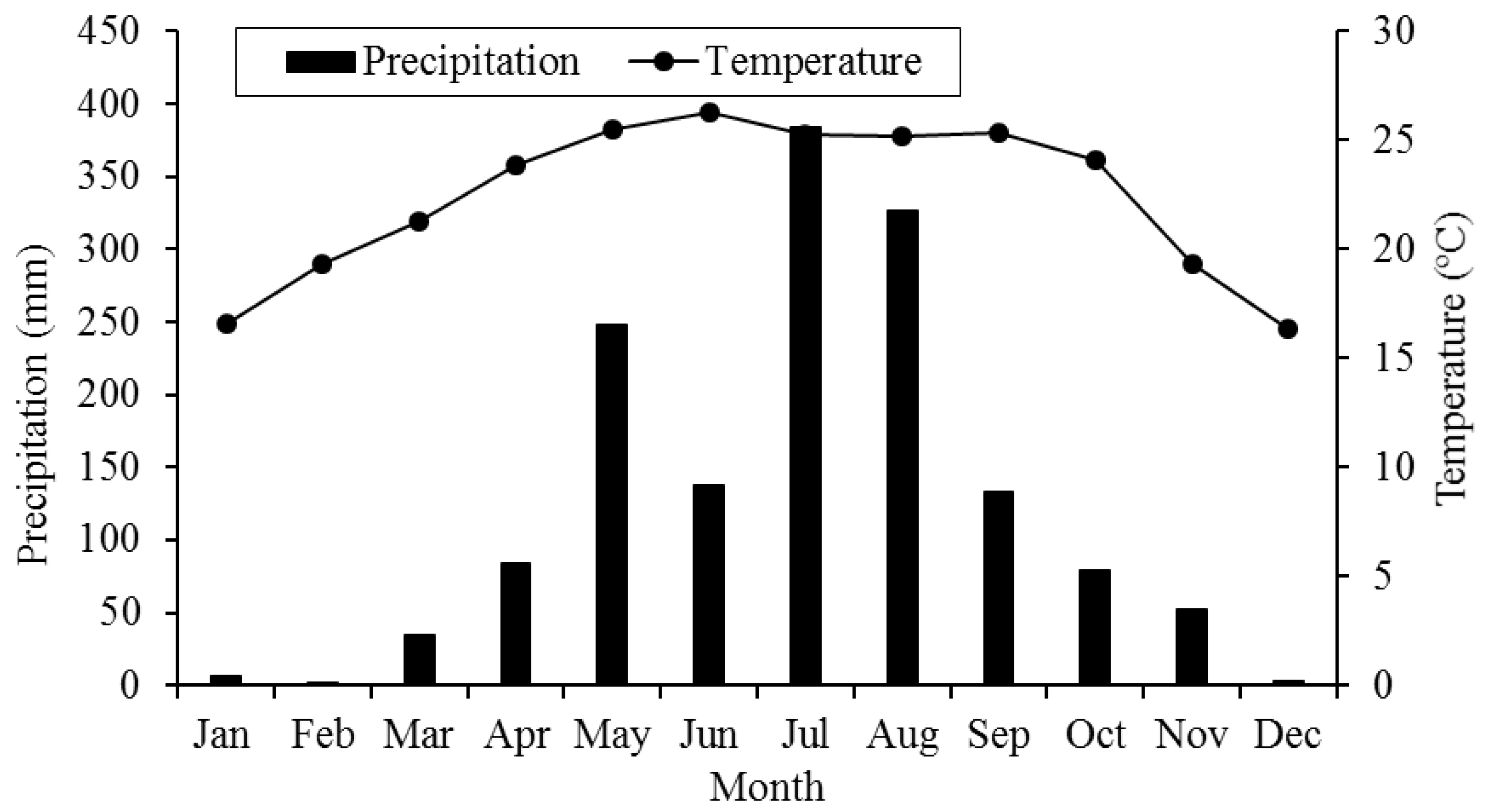
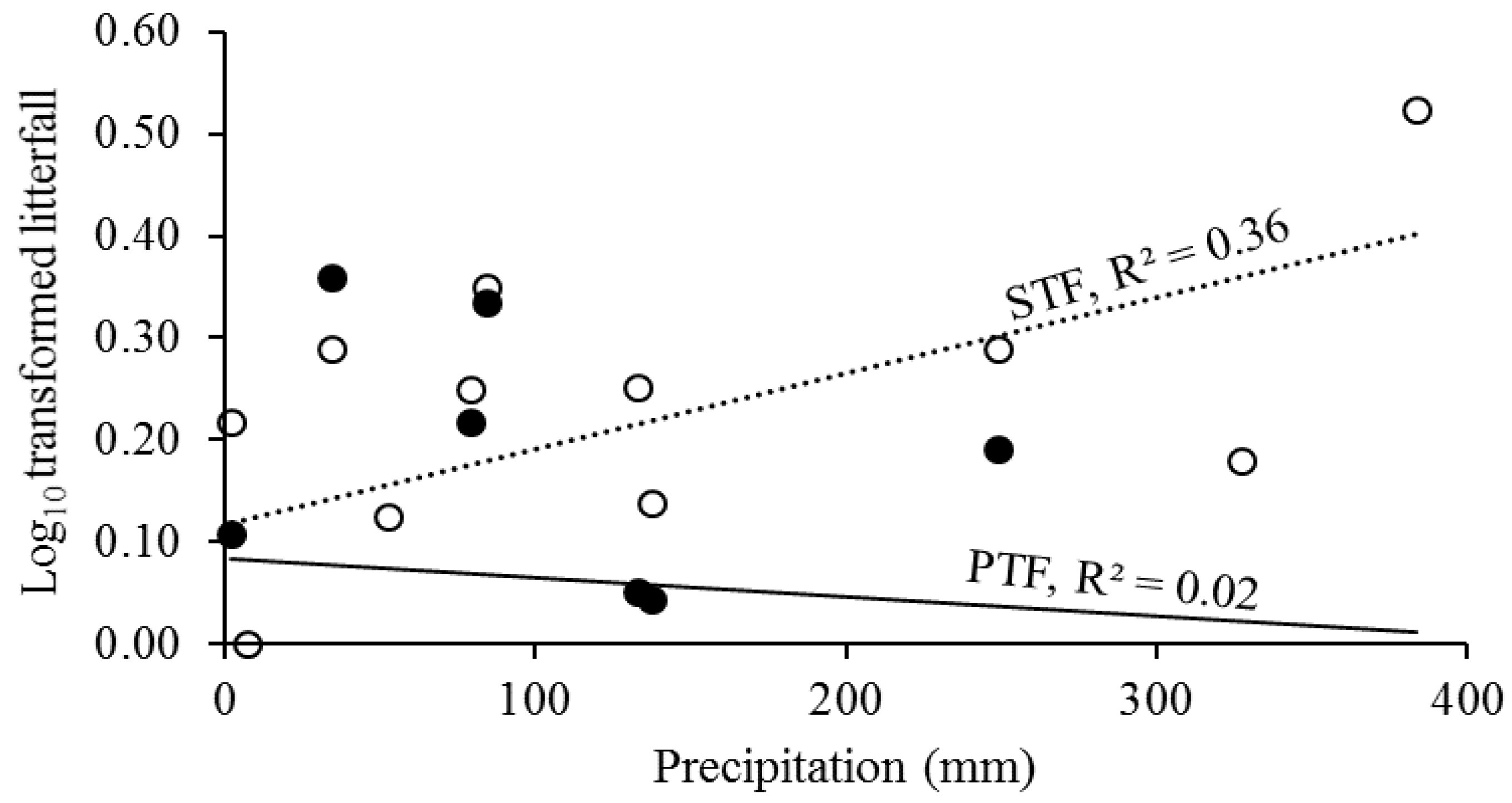
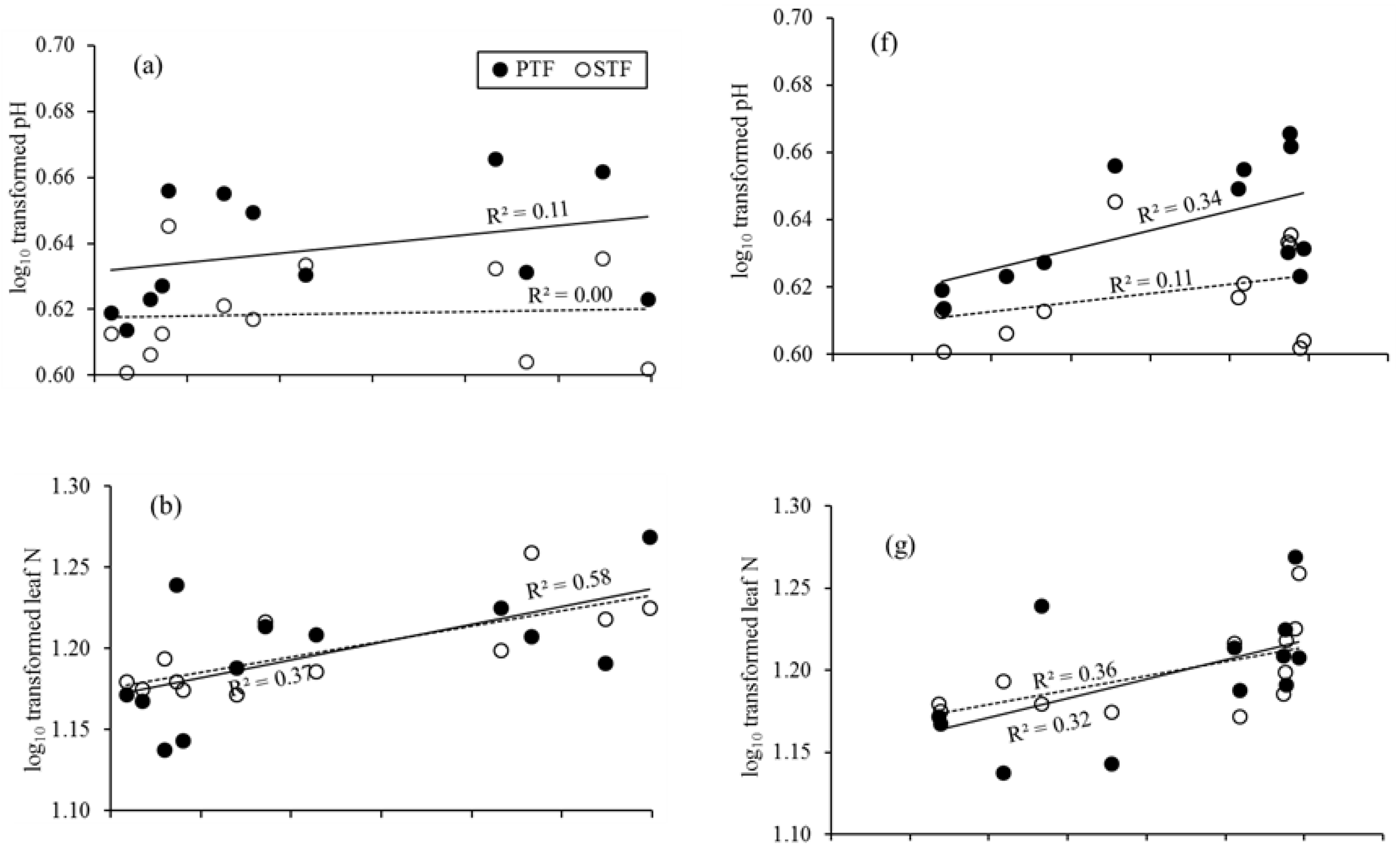
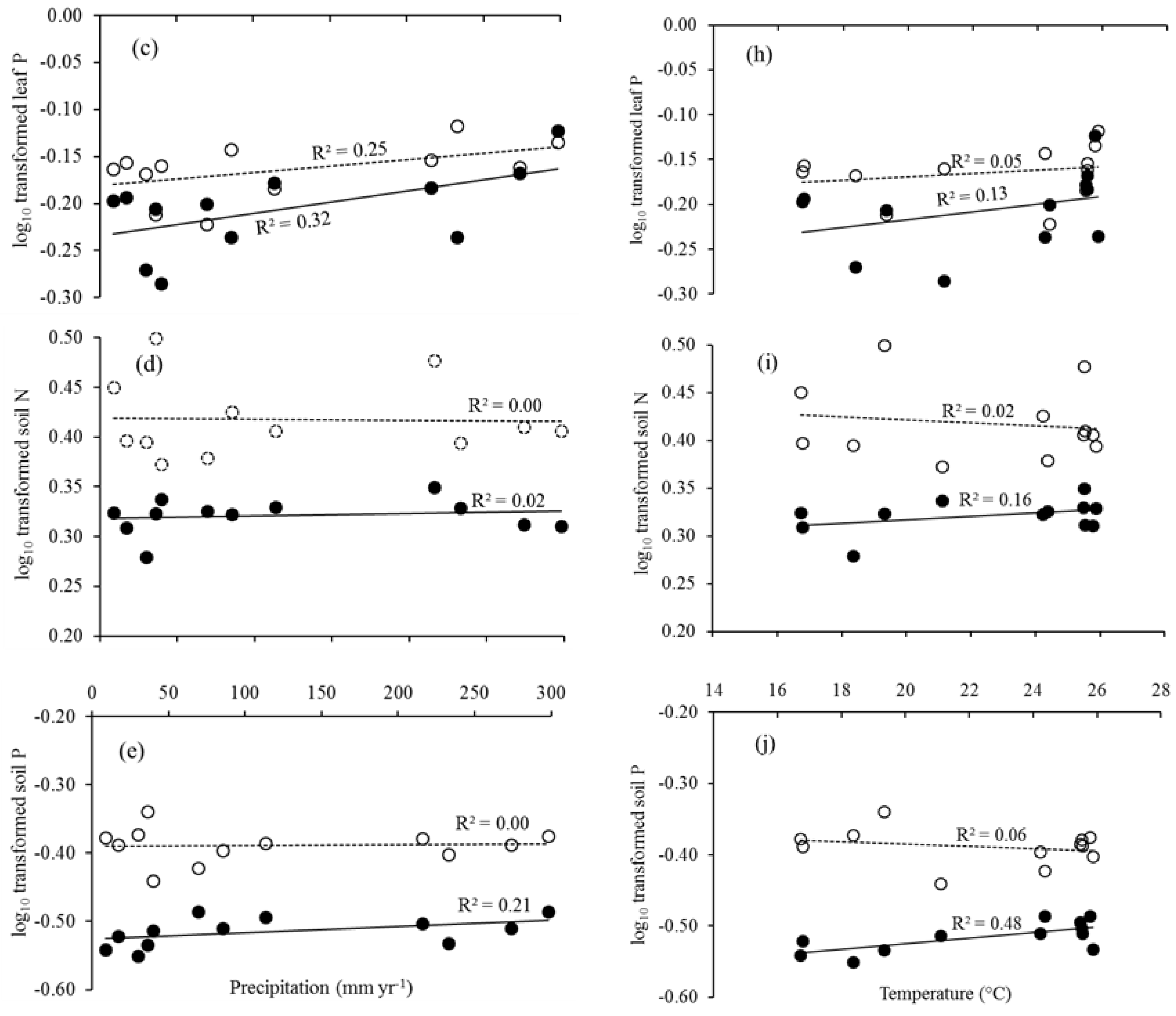
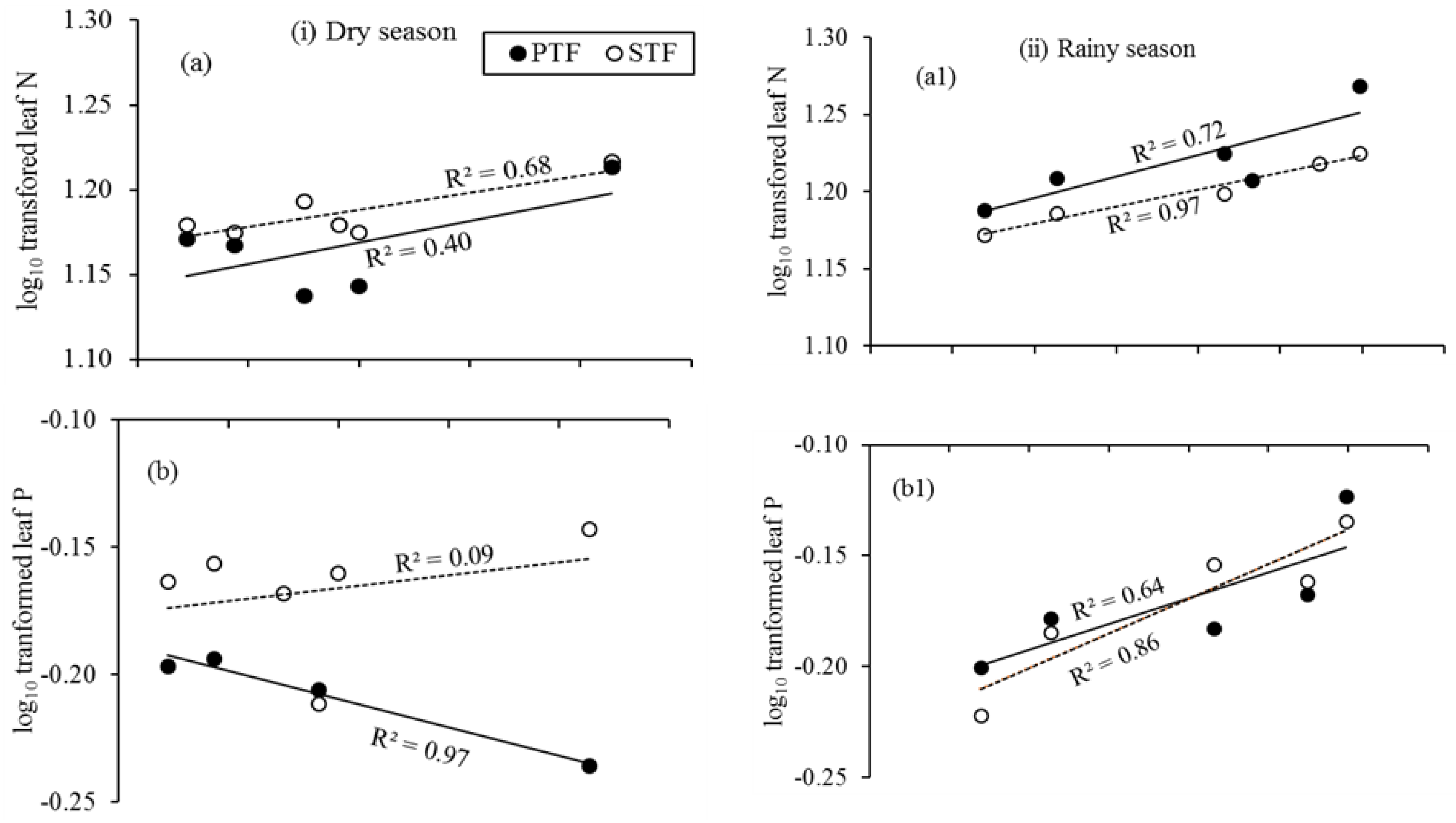
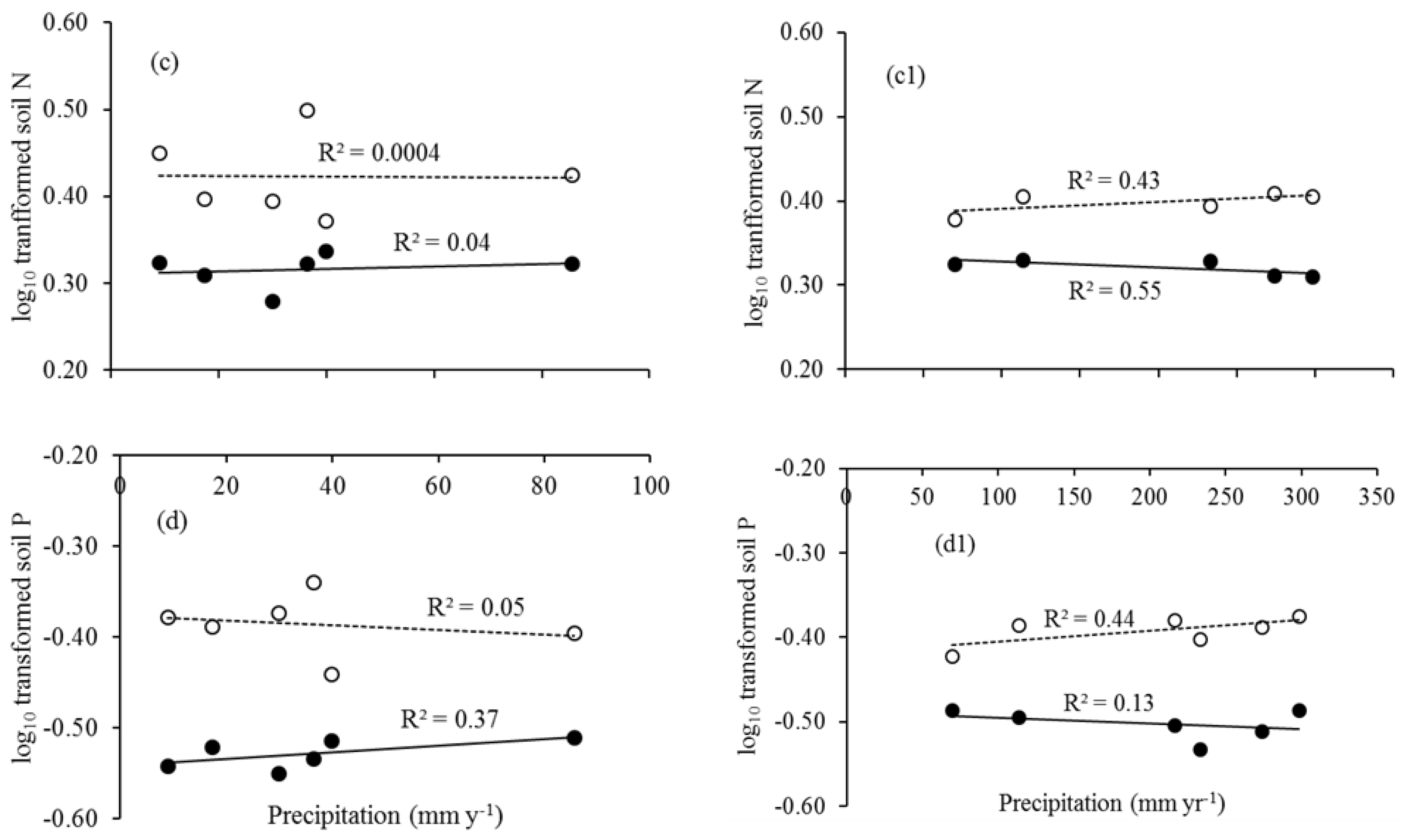
| Variable (n = 12) | Primary Tropical Forest (PTF) | Secondary Tropical Forest (STF) | t-Value | ||||||
|---|---|---|---|---|---|---|---|---|---|
| Mean ± SE | CV (%) | Skewness | K-S Test | Mean ± SE | CV (%) | Skewness | K-S Test | ||
| Precipitation (mm year−1) | 1421.5 ± 9.8 | 90.5 | 0.69 | 0.20 | 1421.5 ± 9.8 | 90.5 | 0.69 | 0.20 | - |
| Temperature (°C) | 22.4 ± 0.8 | 16.5 | −0.61 | 0.27 * | 22.4 ± 0.8 | 16.5 | −0.61 | 0.27 * | - |
| pH | 4.4 ± 0.1 a | 4.2 | 0.34 | 0.23 | 4.2 ± 0.1 b | 3.5 | 0.51 | 0.16 | 2.83 ** |
| Total litterfall (t ha−1 yr−1) | 6.03 ± 0.5 a | 44.3 | 0.83 | 0.18 | 8.3 ± 0.50 a | 37.8 | 1.20 | 0.20 | −1.91 |
| Leaf litter N (g kg−1) | 15.8 ± 0.4 a | 8.9 | 0.35 | 0.10 | 15.8 ± 0.3 a | 6.3 | 1.28 | 0.18 | −0.04 |
| Leaf litter P (g kg−1) | 0.6 ± 0.1 a | 10.3 | 0.13 | 0.15 | 0.7 ± 0.1 b | 6.7 | −0.48 | 0.19 | −2.67 ** |
| Soil N (g kg−1) | 2.1 ± 0.1 a | 3.9 | −0.82 | 0.20 | 2.6 ± 0.2 b | 9.4 | 1.24 | 0.25 * | −7.09 *** |
| Soil P (g kg−1) | 0.3 ± 0.03 a | 4.9 | −0.05 | 0.13 | 0.4 ± 0.04 b | 5.8 | −0.12 | 0.18 | −12.77 *** |
| Variable (n = 12) | PPT | TEMP | pH | LF-PTF | LF-STF | Leaf Litter N | Leaf Litter P | Soil N | Soil P |
|---|---|---|---|---|---|---|---|---|---|
| PPT | 1 | ||||||||
| TEMP | 0.81 * | 1 | |||||||
| pH | 0.23 | 0.50 | 1 | ||||||
| LF-PTF | −0.17 | 0.27 | 0.60 * | 1 | |||||
| LF-STF | 0.54 | 0.60 * | 0.16 | 0.37 | 1 | ||||
| Leaf litter N | 0.79 * | 0.68 * | −0.12 | −0.18 | 0.54 | 1 | |||
| Leaf litter P | 0.77 * | 0.43 | −0.20 | −0.46 | 0.43 | 0.71 * | 1 | ||
| Soil N | 0.01 | −0.01 | 0.14 | −0.12 | −0.15 | 0.28 | 0.07 | 1 | |
| Soil P | 0.32 | 0.19 | −0.22 | −0.47 | 0.31 | 0.54 | 0.48 | 0.52 | 1 |
© 2019 by the authors. Licensee MDPI, Basel, Switzerland. This article is an open access article distributed under the terms and conditions of the Creative Commons Attribution (CC BY) license (http://creativecommons.org/licenses/by/4.0/).
Share and Cite
Mani, S.; Cao, M. Nitrogen and Phosphorus Concentration in Leaf Litter and Soil in Xishuangbanna Tropical Forests: Does Precipitation Limitation Matter? Forests 2019, 10, 242. https://doi.org/10.3390/f10030242
Mani S, Cao M. Nitrogen and Phosphorus Concentration in Leaf Litter and Soil in Xishuangbanna Tropical Forests: Does Precipitation Limitation Matter? Forests. 2019; 10(3):242. https://doi.org/10.3390/f10030242
Chicago/Turabian StyleMani, S., and Min Cao. 2019. "Nitrogen and Phosphorus Concentration in Leaf Litter and Soil in Xishuangbanna Tropical Forests: Does Precipitation Limitation Matter?" Forests 10, no. 3: 242. https://doi.org/10.3390/f10030242
APA StyleMani, S., & Cao, M. (2019). Nitrogen and Phosphorus Concentration in Leaf Litter and Soil in Xishuangbanna Tropical Forests: Does Precipitation Limitation Matter? Forests, 10(3), 242. https://doi.org/10.3390/f10030242





